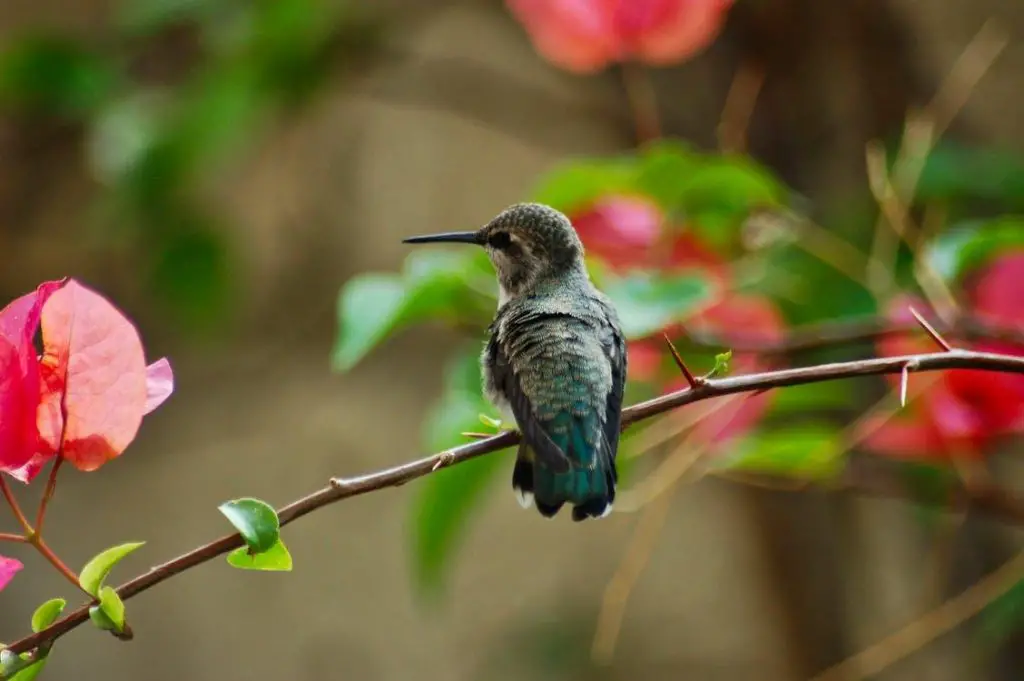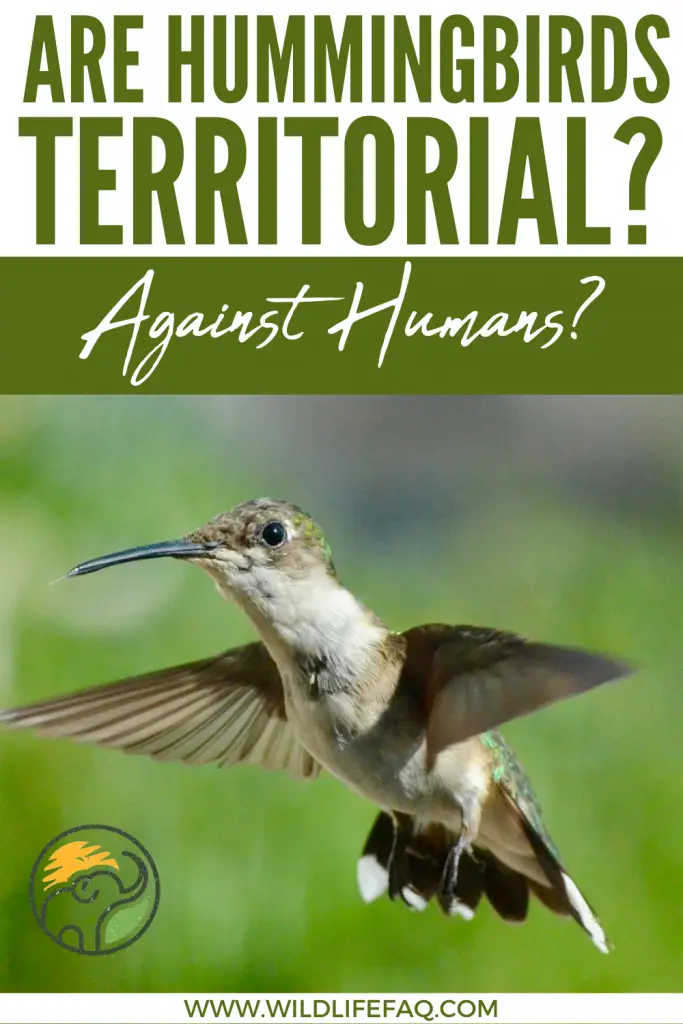Hummingbirds are small birds with more than 300 species that are native to South and North America, but most of the species are found in the tropics.
The size of these birds falls between 5 cm (Bee hummingbird) and 23 cm (Giant hummingbird). Hummingbirds are basically famous for their active lives as they have the fastest wing-flapping capability and the highest metabolic rate of any bird.
Are Hummingbirds Territorial?
Most of the bird species are territorial in nature, mostly during the late spring and early summer when the breeding season arrives. Like the other birds, the humming birds also show aggressive behavior towards their territory, and they also fall under the category of territorial.
The territories of the hummingbirds are established on the basis of the availability of needs such as water, nectar, other food sources, and nesting materials.
Hummingbirds are active in nature and aggressively protect their territory after establishing it. Territories are developed by these birds for several reasons.
Who Shows Territorial Behavior?
Male hummingbirds developed their territories in order to attract females to their environment. As the mating season starts, male birds express territorial behaviors toward females. Male birds show different demonstrations of affection for female birds.
A more virulent male hummingbird has more opportunities to attract a female. Female hummingbirds have a different reason for territorial development.
The basic cause of the development of territory by a female is the nesting of young ones. Female birds select a place that has an enormous amount of feeding and nesting material. Female birds also benefit from the territorial behavior of male birds.
Are Hummingbirds Territorial To Other Birds?
Yes, hummingbirds show territorial behavior to other birds. There are two basic reasons for the territorial behavior of hummingbirds.
The first is that they defend their eggs and newborns in the nests from attackers as they become more territorial in the breeding season.
The second reason for their territorial behavior is related to their feeding behavior. Hummingbirds have an active life, and for that, they require a large amount of energy.
To fulfill their energy needs, they search for more and more food and defend their food sources from other birds, becoming territorial.

When the scarcity of food is caused during the harsh days of early winter, it is noted that the hummingbirds also battle for food.
It is also noted that as the blossoms fade, they can’t afford to share flowers since they have a long way to travel once the nectar is gone.
Hummingbirds that are enraged may be violent well into the fall, defending ideal feeding locations in preparation for migration.
It is noted that the male hummingbirds are more territorial towards the feeders as compared to their female partners, but the female hummingbirds are more territorial towards their nests.
The rufous hummingbird has one of the nastiest tempers of the North American hummingbirds, but all the hummingbird species can demonstrate a range of hostility to varying degrees.
Why Do Hummingbirds Chase Each Other From Feeders?
Many times you have noticed that hummingbirds are chasing one another, and then you might think that they are playing and having fun with each other, having a good time, just like little siblings, but it is not so.
These birds may be battling with each other to the death over territorial space or sometimes show their talents to a nearby female spectator, depending on the scenario.
It is often noted that hummingbirds are also seen chasing each other from the feeders. It is in their instinctive nature to fight over the feeder, just as with their tendency to lash out at rival hummingbirds over nectar-rich blooms in the fields.
What Can Causes Conflict Between Hummingbirds?
Certain things which we don’t consider, can cause active conflict with the birds when they are feeding on a feeder.
As we know that hummingbirds show activeness and territorial behavior during feeding and don’t share their food with other birds, you must increase the number of feeding points for them.
For example, if you didn’t know anything about the common behavior of these creatures when buying a garden feeder, you must have chosen a feeder pot with many ports rather than simply one.
Some of the hummingbird species also become aggressive on the multiport feeders. As a bullish hummingbird is aggressive near a multiport feeder, a bird feeder can use more than one hanging bird feeder at a single feeding point.
Do Hummingbirds Fight Each Other?

Yes, hummingbirds fight each other over feeders, so a bird feeder can arrange a feeder pot with multiple ports. As a feeder pot comprises more than one port, a greater number of birds can feed on the pot, and competition among the feeding birds will be reduced.
It is also noticed that some species of hummingbirds, like bullish hummingbirds, show aggressive behavior over the feeder.
How Do You Stop Hummingbirds From Fighting Over Feeders?
A birdfeeder can arrange more than one hanging bird feeder and then put them in the field so that each of the feeders has a distance of 15 feet from the other.
When the male hummingbirds are feeding, it is best to place each feeder in a place from which the birds cannot see other birds during feeding. As it is, if the birds are not able to see other birds during feeding, the chances of chasing them over the feeder will be reduced.
During the placing of feeders, it must be kept in mind that all of the feeders are hanging with something in the air at an optimum height.
As a feeder wants to feed more birds at a single time, it is suggested that more than one type of feed be used at a single time. It is a well-established fact that different species of hummingbirds consume different choices of food when it is available.
When multiple choices of food are available, there will be a chance of reduced competition. A birdfeeder can use a variety of tube-shaped plants, flowers, and nets like creepers and trumpets.
Small-sized insects are also preferred by those hummingbirds who like to feed on protein. To increase the number of fliers in your feeding field, it is suggested that vast space, shelter, and water be also provided. This will attract more and more birds.
Do Owls Exhibit Territorial Behavior Like Hummingbirds?
Owls and their migration patterns provide intriguing insights into their behavior. While hummingbirds are well-known for their territorial behavior, it is less common in owls. Unlike hummingbirds, owls tend to establish hunting territories rather than defending breeding territories. However, specific species of owls, such as the northern saw-whet owl, may display territorial behavior during their nesting season.
Are Hummingbirds Territorial Towards Humans?
Hummingbirds are aggressive in nature and defend their territories from intruders, but due to their small size, they are not able to cause a serious threat to humans.
It is rarely noticed that hummingbirds attack humans, but if someone tries to disturb their nestlings or act as a predator, then they will become offensive and try to save their territory by flying around the predator.
Hummingbirds are too small to threaten a person. If a person goes near to them, they simply fly away.
Those hummingbirds are fed on a daily basis on a feeder which is installed in a home or nearby humans, after some duration, the birds become friendly towards humans. But those birds which are not accustomed to feeding on a feeder that is installed in a field remain aggressive towards humans.
You can also take a look at our article How To Get a Hummingbird To Trust You

Keywords: hummingbird, Giant hummingbird, territorial, aggressive behavior










